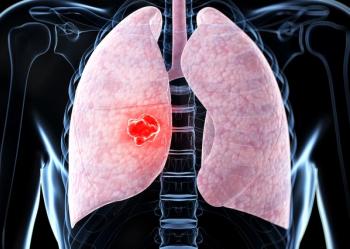
Oncology NEWS International
- Oncology NEWS International Vol 6 No 7
- Volume 6
- Issue 7
Thumbs Down for Smoking in Movies
SAN FRANCISCO--The movie critics Siskel and Ebert rate good movies with a "thumbs up" sign and bad ones with "thumbs down." Now, the Sacramento-Emigrant Trails Affiliate of the American Lung Association (ALA) is using these symbols to rate movies and TV shows in their portrayal of smoking.
SAN FRANCISCO--The movie critics Siskel and Ebert rate good movies witha "thumbs up" sign and bad ones with "thumbs down."Now, the Sacramento-Emigrant Trails Affiliate of the American Lung Association(ALA) is using these symbols to rate movies and TV shows in their portrayalof smoking.
Productions devoid of tobacco usage and advertising and those containingantismoking directives earn a thumbs up, while those depicting active smokingor glimpses of a particular brand of cigarettes or a Joe Camel billboardget a thumbs down.
Oscars, Emmys, and 'Phlemmys'
The Thumbs Up! Thumbs Down! program also engages in publicity activities,including the "Hackademy Awards and the Phlemmys." They coincidewith the Academy Awards and Emmys and are presented to features in whichtobacco is used or advertised. To reward positive films and TV programsthat show minimal tobacco use or carry antitobacco messages, the groupalso awards a "Pink Lung."
In 1996, Pink Lungs went to the television series Frasier and The X-Files,while, ironically, a show in which physicians are the main characters,Chicago Hope, received the Phlemmy.
The 1996 Pink Lung for best movie went to Babe, a family film in whichneither the talking animals nor the human actors used tobacco.
Speaking at a panel session at the American Thoracic Society/AmericanLung Association International Conference, Trisha Gibson, program managerfor Thumbs Up! Thumbs Down!, said that "our main objective is to educateand inform the public, generally, and teenagers, particularly, about tobaccomessages that are being aimed at them." Added Curt Mekemson, projectconsultant: "Our aim is to take action to reduce the glamorizationof tobacco use in movies, television, and videos."
When Congress banned cigarette advertising on TV in 1970, tobacco companiesturned their attention to other means of attracting customers--and theentertainment industry proved accommodating. A study published in the AmericanJournal of Public Health showed that movie heroes are three times morelikely to smoke than Americans in real life.
While major strides have been made in reducing tobacco use among adults,young people have continued to smoke at the same rate for the past decade.
Said Mr. Mekemson: "One of the powerful ways young people receiveinformation on tobacco is through watching movies, TV, and music videos.When you see an advertisement, you know it is an advertisement, but whenyou see your favorite actor or actress enjoying a smoke, there is no warningabout tobacco use, and young people receive the message that tobacco useis okay and desirable."
Thumbs Up! Thumbs Down!--a joint project of the Sacramento ALA affiliate,the ALA of Los Angeles County, and the national ALA--is funded by California'sTobacco Health Protection Act of 1988, popularly known as Proposition 99,which placed a tax on tobacco products and raises roughly $80 million ayear for prevention efforts.
The project butts up against many obstacles, but the most daunting arethe traits and practices already ingrained in the entertainment industry.Directors rely upon set forms: The wealthy person flaunts a cigar; therebellious teenager lights up a cigarette (smoking under a "No Smoking"sign symbolizes the height of defiance); women bucking the system, as inThe First Wives Club, light up cigarettes or cigars. The cigar,in fact, has become the universal symbol of reward.
Program Uses Teenage Reviewers
Using the slogan "Watch What You're Watching!" the projectis recruiting young people to become critical viewers. Teenagers conductevaluations of movies, videos, and TV shows using a guide that weightsand quantifies various infractions (eg, two people smoking is worse thanone; a fleeting shot of a tobacco display in a store window rates lessthan a person lighting up under stress).
Reviewers must be over 15 years of age and have their parents' consent.They are reimbursed for the cost of their movie tickets and video rentals.
The program evaluates more than 130 movies a year. In 1995, 23% of moviesreviewed had no tobacco in evidence; 26% had 1 to 10 incidents; 23% had11 to 14 incidents; 18% had 25 to 49 incidents; and 11% had more than 50incidents.
Interestingly, while only 3% of the US population smokes cigars, 52%of movies showed people smoking cigars. In 82% of movies displaying tobaccouse, the user was the lead and/or supporting actor.
Movies displayed about five times as much tobacco use as TV. However,women smoked more on TV than in movies. Of 238 TV episodes evaluated, 202(85%) had no tobacco use. In episodes including tobacco, 67% had cigaretteuse, 42% cigar use, and 3% pipe use.
The program also encourages teens to write or e-mail key people in theentertainment industry to express their concern over how tobacco is portrayedon the screen. "Our aim is to raise the level of awareness,"Mr. Mekemson said. "We have become a loud, if not the main, voicetelling the world what is happening in movies and TV."
The ultimate goal is to convince the entertainment industry that itis to their advantage, and the benefit of the public, to eliminate theglorification of tobacco in their productions.
Articles in this issue
over 28 years ago
Researchers Report Conflicting Data on Cervical Cancer in AIDSover 28 years ago
CIN Website Now Offers Daily Online Cancer Newspaperover 28 years ago
Members Sought for Director's Consumer Liaison Group: NCIover 28 years ago
Trial Attempts to Reverse Taxol Resistance in Ovarian Cancerover 28 years ago
Taxotere Bests Adriamycin in Metastatic Breast Cancerover 28 years ago
Antiemetic Tablets Prove Equal in Efficacy to IV Drug Regimenover 28 years ago
Preop Chemotherapy May Have Advantages in Primary Breast Cancerover 28 years ago
Doxorubicin Benefits Older Breast Cancer PatientsNewsletter
Stay up to date on recent advances in the multidisciplinary approach to cancer.

















































































